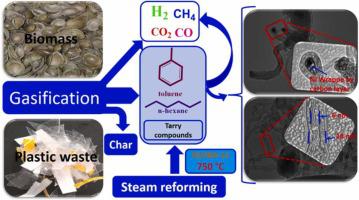Journal of Environmental Chemical Engineering ( IF 7.4 ) Pub Date : 2021-09-20 , DOI: 10.1016/j.jece.2021.106383 Félix Mérimé Bkangmo Kontchouo 1 , Zhiran Gao 1 , Xianglin Xianglin 1 , Yiran Wang 1 , Yifan Sun 1 , Shu Zhang 2 , Xun Hu 1

|
Plastic wastes are potential feedstock for the production of hydrogen via gasification. Aliphatic hydrocarbons and aromatic hydrocarbons are important fractions from pyrolysis of plastic wastes, which might show the different reaction behaviors in steam reforming reactions due to their distinct molecular structures. To explore this, in this study, steam reforming of n-hexane and toluene, two model compounds representing respective aliphatic hydrocarbons and aromatic hydrocarbons, over Ni/SBA-15 catalyst were carried out. The in-situ diffuse reflectance infrared Fourier transform spectroscopy (DRIFTS) characterization of the steam reforming indicated that the dissociative absorption of n-hexane on nickel took place even at 100 °C, form abundant CHx species and consequently more CH4 in gaseous products. Nevertheless, the reaction intermediates from n-hexane could be gasified by the  OH from adsorbed water rapidly. In comparison, the fragments from dissociative adsorption of toluene reacted with hydroxyl group of water, forming the stable intermediates bearing
OH from adsorbed water rapidly. In comparison, the fragments from dissociative adsorption of toluene reacted with hydroxyl group of water, forming the stable intermediates bearing  OH, C
OH, C O, C
O, C O
O C and C
C and C C functionalities, which were the precursors of coke and resulted in more serious coking. The coke from steam reforming of toluene showed a higher thermal stability, higher resistivity to oxidation as it was more aromatic and contained more defective with big fused ring structures. In addition, the majority carbon nanotubes generated during steam reforming of toluene had an inner diameter of 3–6 nm and outer diameter of 10–20 nm. Nickel species on tip of the nanotubes were wrapped with a carbon layer, which contributed to the deactivation of the catalyst in steam reforming of toluene.
C functionalities, which were the precursors of coke and resulted in more serious coking. The coke from steam reforming of toluene showed a higher thermal stability, higher resistivity to oxidation as it was more aromatic and contained more defective with big fused ring structures. In addition, the majority carbon nanotubes generated during steam reforming of toluene had an inner diameter of 3–6 nm and outer diameter of 10–20 nm. Nickel species on tip of the nanotubes were wrapped with a carbon layer, which contributed to the deactivation of the catalyst in steam reforming of toluene.
中文翻译:

正己烷和甲苯的蒸汽重整:了解脂肪烃和芳香烃的结构差异对其结焦行为的影响
塑料废物是通过气化生产氢气的潜在原料。脂肪烃和芳香烃是塑料废物热解的重要馏分,由于其不同的分子结构,它们可能在蒸汽重整反应中表现出不同的反应行为。为了探索这一点,在本研究中,对分别代表脂肪烃和芳香烃的两种模型化合物正己烷和甲苯在 Ni/SBA-15 催化剂上进行了蒸汽重整。蒸汽重整的原位漫反射红外傅里叶变换光谱 (DRIFTS) 表征表明,即使在 100 °C 下,正己烷在镍上的解离吸收也会发生,形成丰富的 CH x物种,从而形成更多的 CH 4在气体产品中。然而,正己烷的反应中间体可以被 吸附水中的OH 迅速气化。相比之下,甲苯解离吸附的碎片与水的羟基反应,形成稳定的中间体,含有
吸附水中的OH 迅速气化。相比之下,甲苯解离吸附的碎片与水的羟基反应,形成稳定的中间体,含有 OH、
OH、 CO、C
CO、C  O
O  C 和 C
C 和 C C 官能团,这是焦炭的前体,导致更严重的焦化。甲苯蒸汽重整产生的焦炭显示出更高的热稳定性和更高的抗氧化性,因为它更芳香,并且含有更多具有大稠环结构的缺陷。此外,甲苯蒸汽重整过程中产生的大部分碳纳米管的内径为 3-6 nm,外径为 10-20 nm。纳米管尖端的镍物质被碳层包裹,这有助于甲苯蒸汽重整中催化剂的失活。
C 官能团,这是焦炭的前体,导致更严重的焦化。甲苯蒸汽重整产生的焦炭显示出更高的热稳定性和更高的抗氧化性,因为它更芳香,并且含有更多具有大稠环结构的缺陷。此外,甲苯蒸汽重整过程中产生的大部分碳纳米管的内径为 3-6 nm,外径为 10-20 nm。纳米管尖端的镍物质被碳层包裹,这有助于甲苯蒸汽重整中催化剂的失活。











































 京公网安备 11010802027423号
京公网安备 11010802027423号